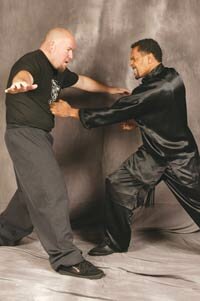The dragon form combines internal and external energy to produce awesome and devastating strikes. Dragon techniques feature circular movements that can penetrate with sudden explosiveness. Though the claw is the primary hand technique used within the dragon form, there are also various palm and fist attacks that add to the dragon form's effectiveness. However, using the waist in a whipping action to generate power is essential to the development of proper dragon energy. The dragon form uses internal conditioning through proper breathing techniques to develop qi (internal energy). This is done by using the lower body to pull in air with relaxed breaths. The breathing develops flexibility, strength and power.
 |
| Leopard defense. From a ready position (1) |
 |
| the attacker opens with a right snap kick (2) |
 |
| Early uses a left-arm downward block and right horizontal leopard strike to the throat. He follows with a left vertical leopard strike to the solar plexus (3) |
 |
| and a right leopard strike to the groin (4) |
 |
| The finishing move is a left thrust kick to the chest (5) |
3 Stages of Training
Once the five animal practitioner has mastered the pattern within the form, he practices the three stages of training. In the first stage, the practitioner performs the whole form slowly, mimicking tai chi or moving meditation. The slow and soft movements massage the organs and lead to health and longevity. The martial artist also learns the essence of each animal by moving slowly and methodically. Breathing is deep and from the abdomen to improve the circulatory system and build the practitioner's qi.
The second stage of training is practiced with external power. The emphasis is on conditioning the bones, tendons and muscles, while developing speed and power. This type of training helps the practitioner build strong stances while increasing stamina and external strength. The five animal practitioner puts all his skills together in the third stage of training. The emphasis is on the spirit and strengths of each animal-both internal and external energy are intertwined to give each animal life within the form.
The snake and crane forms are performed with relaxation and soft, or internal, energy until explosive power is released at the moment of impact. The tiger and leopard produce devastating, lethal attacks that are performed with quick and powerful, yet relaxed, external energy. The dragon combines both internal and external movements to deliver powerful techniques.
Five animal training not only provides the martial artist with the strength and power for devastating fighting techniques, but also teaches him to remain calm and relaxed in even the most dangerous self-defense situations.
I have truly benefited from the health aspects I received from studying five animal kung-fu. My kung-fu training contributed greatly to my success and longevity in the NFL and even though I am now retired, five animal remains an integral part of my physical and emotional well-being.




0 comments:
Post a Comment